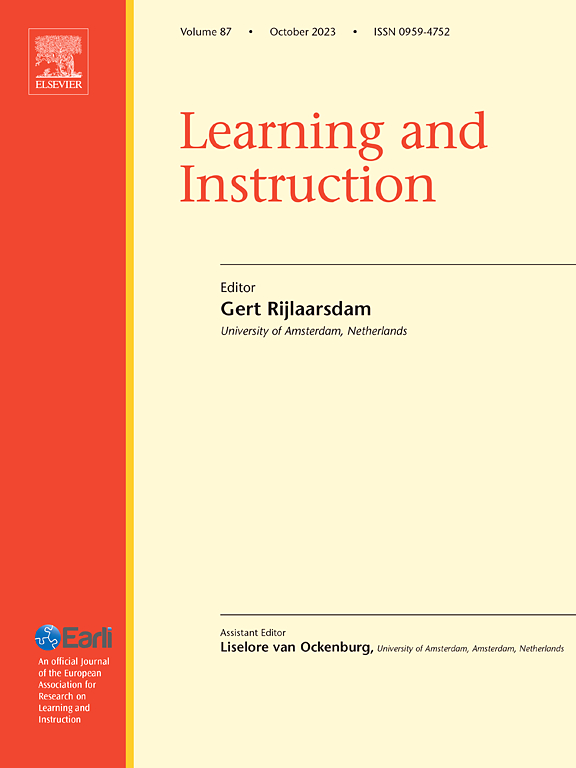父母的空间谈话预示着幼儿空间语言的发展
IF 4.9
1区 教育学
Q1 EDUCATION & EDUCATIONAL RESEARCH
引用次数: 0
摘要
听到更频繁的空间语言的幼儿表现出更好的空间技能(Casasola et al., 2020)。此外,游戏环境也会影响父母使用空间语言的程度(Ferrara et al., 2011)。然而,大多数研究都集中在学龄前儿童身上,并没有具体分析不同游戏环境中不同类型的空间语言与结果的关系。目的本研究探讨了父母在空间和非空间游戏中使用空间关系语言(如“旁边”、“下面”)和其他空间语言如何预测幼儿并发和后来的语言和非语言空间技能。该研究涉及来自美国东北部的169名社会经济状况不同的两岁儿童及其父母。方法二组完成了三个结构化的游戏活动,包括一个空间谜题任务和两个非空间活动。在2岁和3岁时,儿童完成了修改版本的点到空间关系任务(Casasola et al., 2020)和空间组装测试(Verdine et al., 2014)。结果父母在拼图任务中使用空间关系语言可以预测孩子在2岁时(β = .24, p = .02)和1年后3岁时(β = .19, p = .04)在点-空间关系任务中的表现。父母在非空间活动中使用其他空间语言和空间关系语言与儿童的空间技能无关。结论:在空间游戏环境中频繁接触空间关系语言有助于幼儿对空间术语的并发理解和后续理解,强调了提供促进空间语言理解的特定学习机会的重要性。本文章由计算机程序翻译,如有差异,请以英文原文为准。
Parents’ spatial talk predicts toddlers’ spatial language gains
Background
Young children who hear more frequent spatial language demonstrate better spatial skills (Casasola et al., 2020). Additionally, play contexts can influence how much spatial language parents use (Ferrara et al., 2011). However, most studies have focused on preschoolers and have not specifically analyzed how different types of spatial language within various play contexts relate to outcomes.
Aims
The present study investigates how parents' use of spatial relational language (e.g., "next to," "below") and other spatial language during spatial and non-spatial play predicts toddlers’ concurrent and later verbal and non-verbal spatial skills.
Sample
The study involved 169 socio-economically diverse 2-year-olds and their parents from the Northeastern United States.
Methods
Dyads completed three structured play activities, including a spatial puzzle task and two non-spatial activities. At age 2 and 3, children completed modified versions of the Point-to-Spatial-Relation task (Casasola et al., 2020) and the Test of Spatial Assembly (Verdine et al., 2014).
Results
Parents' use of spatial relational language during the puzzle task predicted better performance on the Point-to-Spatial-Relation task concurrently at age 2 (β = .24, p = .02) and one year later at age 3 (β = .19, p = .04). Parents' use of other spatial language and spatial relational language during non-spatial activities was not associated with children's spatial skills regardless of age.
Conclusions
Frequent exposure to spatial relational language within a spatial play context supports toddlers' concurrent and later comprehension of spatial terms, highlighting the importance of providing specific learning opportunities that promote understanding of spatial language.
求助全文
通过发布文献求助,成功后即可免费获取论文全文。
去求助
来源期刊

Learning and Instruction
Multiple-
CiteScore
11.30
自引率
4.80%
发文量
109
期刊介绍:
As an international, multi-disciplinary, peer-refereed journal, Learning and Instruction provides a platform for the publication of the most advanced scientific research in the areas of learning, development, instruction and teaching. The journal welcomes original empirical investigations. The papers may represent a variety of theoretical perspectives and different methodological approaches. They may refer to any age level, from infants to adults and to a diversity of learning and instructional settings, from laboratory experiments to field studies. The major criteria in the review and the selection process concern the significance of the contribution to the area of learning and instruction, and the rigor of the study.
 求助内容:
求助内容: 应助结果提醒方式:
应助结果提醒方式:


